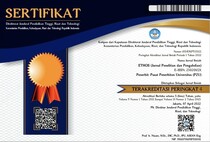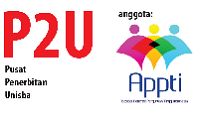Analisis Discounted Cash Flow (DCF) dalam Investasi Tambang dan Kelayakan Ekonomi pada Ekstraksi Timah dengan Menggunakan Teknologi Klorinasi Basah
Abstract
Abstract. Indonesian tin production covers about 30% of the demand for tin commodity in the world. The high level of tin demand in the world and the limited reserves of natural resources for the commodity of tin, encourage more effective and efficient utilization. So it is necessary to do a lot of research from upstream from exploration to downstream to metallurgical processes as well as improving the technology of all elements to be more effective and efficient. In addition, research must be carried out in terms of investment and economic feasibility, so that the availability of tin commodity reserves can be carried out to improve the nation's economy. Many methods are used in modeling the projected Net Present Value (NPV) to determine its economic viability by using Discounted Cash Flow (DCF). The investment cost for tin extraction using the wet chlorination method is USD. 1,181,623 for the pre-operational phase, USD. 2,084,219 for the engineering phase and USD. 3,602,736 for investment in operational ownership and workers' wages. Investment analysis using the Discounted Cash Flow (DCF) method assuming a cost of equity of 11.37%, a risk free rate of 7.89%, 100% Equity Beta, 11.37% market return and a minimum IRR of 10. 37%. The fund invested in this tin extraction is USD. 6,868,578 in 15 years, with an NPV of USD. -18,943,455, so the Internal Rate Return (IRR) is 0.029% with a minimum IRR of 9.97
Keywords: Tin, Discounted Cash Flow, Investment
Abstrak. Produksi timah indonesia mencakup sekitar 30% dari permintaan komoditi timah di dunia. Besarnya tingkat permintaan timah di dunia ini serta keterbatasan cadangan sumberdaya alam komoditi timah, mendorong pemanfaatan harus lebih efektif dan efisien. Sehingga perlu banyak dilakukan penelitian dari hulu mulai dari ekplorasi hingga ke hilir sampai proses metalurgi serta meningkatkan teknologi dari semua unsur untuk dapat lebih efektif an efisien tersebut. Selain itu juga, harus dilakukan penelitian dalam hal investasi dan kelayakan ekonomi, sehingga ketersediaan cadangan akan komoditi timah dapat berjalan untuk meningkatkan perekonomian bangsa. Banyak hal metode yang dilakukan dalam memodelkan Net Present Value (NPV) yang diproyeksikan untuk mengetahui kelayakan ekonominya dengan menggunakan Discounted Cash Flow (DCF). Biaya investasi ektraksi timah menggunakan metode klorinasi basah adalah USD. 1.181.623 untuk tahap pra operasional, USD. 2.084.219 untuk tahap engineering dan USD. 3.602.736 untuk investasi kepemilikan operasional dan upah pekerja. Analisis investasi dengan menggunakan metode Discounted Cash Flow (DCF) dengan asumsi cost of equity sebesar 11,37%, risk free rate sebesar 7,89%, Equity Beta sebesar 100%, Market return sebesar 11,37% dan IRR minimum sebesar 10,37%. Dana yang diinvestasikan dalam ektraksi timah ini adalah USD. 6.868.578 dalam 15 tahun, dengan hasil NPV sebesar USD. -18.943.455, sehingga Internal Rate Return (IRR) sebesar 0,029% dengan IRR minimum sebesar 9,97
Kata Kunci : Timah, Discounted Cash Flow, Investasi
Keywords
Full Text:
PDFReferences
Bernd Lehmann, 2020. Formation of tin ore deposits: A reassessment. Lithos, In Press, Journal Pre-proof. https://doi.org/10.1016/j.lithos.2020.105756.
Eduardo A.Brocchi, Francisco J.Moura. 2008. Chlorination methods applied to recover refractory metals from tin slags. Mineral Engineering, Volume 21, Issue 2, page 150-156. https://doi.org/10.1016/j.mineng.2007.08.011.
Gretel Bernal, José Francisco Martínez-Trinidad, etc. 2020. A PSO-based algorithm for mining association rules using a guided exploration strategy. Pattern Recognition Letters, Volume 138, October 2020, Pages 8-15. https://doi.org/10.1016/j.patrec.2020.05.006.
Joaquín Jara. 2017. Determinants of country competitiveness in attracting mining investments: An empirical analysis. Resources Policy, Volume 52, June 2017, Page 65-71. https://doi.org/10.1016/j.resourpol.2017.01.016.
N.K.Sapari, H.Zabidi, K.S.Ariffin. 2016. Geochemical Prospecting of tin Mineralization Zone at Belukar Semang Prospect, Gerik, Perak. Procedia Chemistry, Volume 19, 2016, Page 729-736. https://doi.org/10.1016/j.proche.2016.03.077.
Noor Fauzi Isniarno, Muhammad Reyhand Alfarrel, Bagea Bagja Gumelar. 2020. Optimasi Iterasi Dan Root Means Square (Rms) Dalam Penentuan Batas Litologi Dari Vertikal Elektrical Sounding (Ves). Ethos : Journal Penelitian dan Pengabdian Kepada Masyarakat (Sains & Teknologi), Volume 8 No. 1. https://doi.org/10.29313/ethos.v8i1.5058.
Ungki Lee, Namwoo Kang, Ikjin Lee. Choice data generation using usage scenarios and discounted cash flow analysis. Journal of Choice Modelling, 2020, 100250. https://doi.org/10.1016/j.jocm.2020.100250.
Zhenxing Xing, Gongjin Cheng, HeYang. 2020. Mechanism and application of the ore with chlorination treatment: A review. Mineral Engineering, Volume 154, 106404. https://doi.org/10.1016/j.mineng.2020.106404
DOI: https://doi.org/10.29313/ethos.v9i1.6626
Refbacks
- There are currently no refbacks.
Alamat Redaksi:
LPPM Unisba, Lantai 2, Jl. Purnawarman 63, Bandung 40116, Jawa Barat, (022) 4203368 , (022) 4264064. ethos.unisba@gmail.com / ethos@unisba.ac.id

This work is licensed under a Creative Commons Attribution-NonCommercial-ShareAlike 4.0 International License.














